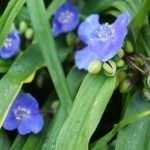Monarchs have evolved to take advantage of a wide range of milkweed host plants. We can help them out by increasing the diversity of native plants in our landscapes.
The winter deep freeze certainly disrupted the human-built landscape. Tropical plants that had stood in defiance of winter for 30 years or more were brought down overnight.
With all the destruction around us, we assumed the worst for the natural environment, especially for one species of charismatic butterfly: the monarch. Fortunately, the gloom and doom of February isn’t playing out for these majestic beauties.
The wild milkweed populations I visit annually are robust and full of healthy monarchs. In central San Antonio, there are fields of zizotes and north of the city plentiful populations of antelope horn are flourishing with about every third plant supporting one or two monarch caterpillars.
And in my own yard, I noticed something new this year — a monarch caterpillar using a tayalote milkweed vine as a host plant. While I knew it was theoretically possible for monarchs to lay their eggs on this plant, I had only ever seen queen butterfly larvae on it before. Usually in March, tayalote has only old leaves left over from the year before, but I think the freeze actually stimulated the new growth that the monarch selected for her eggs.
This spring has taught me a valuable lesson in the importance of diversity. When we rely too much on one specific plant species and that one plant has a bad year, the whole system suffers.
Monarchs have evolved to take advantage of a wide range of milkweed host plants. When there is a disruption for one species of milkweed they take advantage of a different species. To help the monarch migration, as gardeners we need to mimic local natural areas and diversify our offerings of milkweed species. If I hadn’t been growing tayalote just for the fun of it, that mother monarch wouldn’t have had a suitable plant for her eggs.
It’s not natural fluctuations of temperature and climate that are harming monarch populations, but habitat loss and human-caused climate change. To reverse the global trend of species extinction seen today, we have to find a way to make our built landscapes more closely resemble local natural ones.
The first step is to increase the diversity of native plants in our landscapes. If we do, it is a win-win. Increasing diversity supports wildlife and our pocketbooks won’t feel the strain of replacing tropical plants in the spring.




